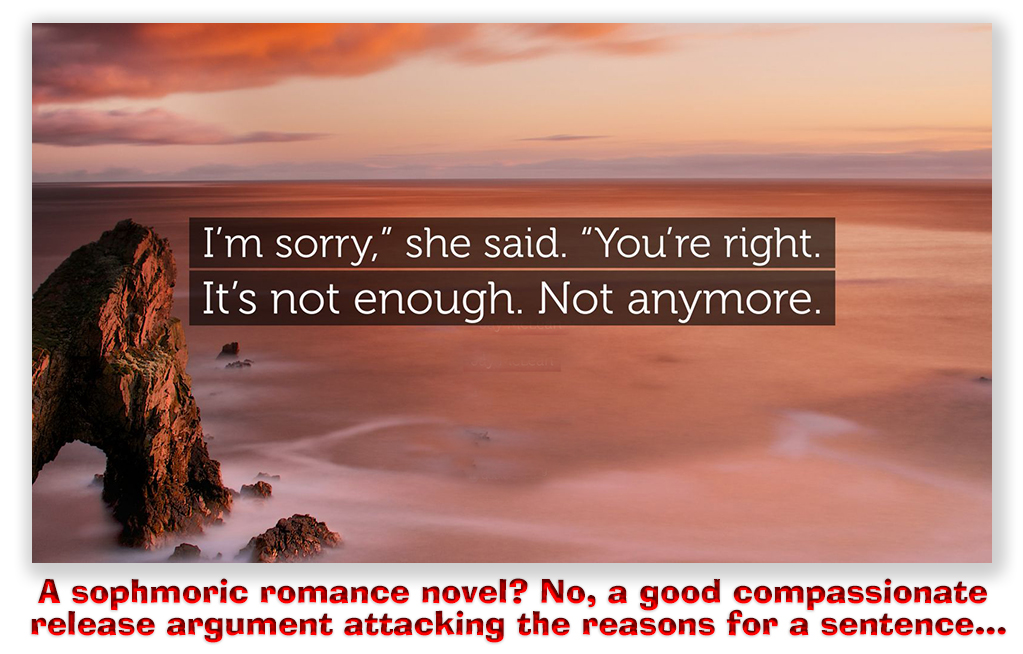We post news and comment on federal criminal justice issues, focused primarily on trial and post-conviction matters, legislative initiatives, and sentencing issues.

10TH CIRCUIT SAYS ‘EXTRAORDINARY AND COMPELLING REASONS’ APPLY TO SENTENCING FACTORS, TOO
 As a procedure, compassionate release is still fairly new. Courts have only had to develop the standards for judging what constitutes an extraordinary and compelling reason for a sentence reduction and what 18 USC § 3582(c)(1)(A)’s squishy directive that a court “consider[]the factors set forth in section 3553(a) to the extent that they are applicable” means in the last five years.
As a procedure, compassionate release is still fairly new. Courts have only had to develop the standards for judging what constitutes an extraordinary and compelling reason for a sentence reduction and what 18 USC § 3582(c)(1)(A)’s squishy directive that a court “consider[]the factors set forth in section 3553(a) to the extent that they are applicable” means in the last five years.
A compassionate release motion must begin with the concession that the sentence was “sufficient but not greater than necessary” and thus complied with 18 USC § 3553(a) when it was imposed. But as 4th Circuit Chief Judge Roger Gregory persuasively argued in United States v. Kibble three years ago, if “a district court’s original 3553(a) analysis could always prove that a sentence reduction would intolerably undermine the 3553(a) factors, then 18 USC 3582(c)(1) would, in effect, be a nullity.”
In other words, a prisoner’s reasons for a sentence reduction are relevant to the 3553(a) factor analysis as well as to the “extraordinary and compelling” standard.
The 10th Circuit reminded us of that last week. Jason Bradley filed for compassionate release, arguing that his kids needed a caregiver. The district court turned him down on § 3553(a) factors because Jason’s lengthy record didn’t convince the judge that Eddie would not commit new crimes.
On appeal, Jason complained the district court “analyz[ed] the § 3553(a) factors as frozen at the time of the 2015 sentencing” and “did not consider the significant mitigation” since the original sentencing, such as age, more than eight years of sobriety and exemplary conduct in prison. He acknowledged that the court did not need to make a finding on extraordinary and compelling reasons in order to deny a compassionate release, but by “failing to consider the facts supporting extraordinary and compelling reasons for release’ within its 3553(a) analysis… the district court committed legal error.
The 10th agreed with Jason: a district court may dispose of a motion for compassionate release at any of the three statutory steps – lack of extraordinary and compelling reason, noncompliance with applicable Sentencing Commission policy, or inconsistency with § 3553(a) sentencing factors. However, the Circuit held that “the facts allegedly establishing extraordinary and compelling reasons for release are relevant to the § 3553(a) analysis” and thus, a district court cannot “deny compassionate-release relief on the ground that release is not appropriate under 3553(a) if the court has not considered the… extraordinary and compelling reasons for release.”
Jason still lost because he had not properly preserved his argument. But the 10th’s analysis is important guidance for anyone writing a compassionate release motion. Be sure to explain why the extraordinary and compelling reasons for release impact the § 3553(a) analysis, or, basically, “Why does a sentence that made sense then not make sense now?”
United States v. Bradley, Case No 23-1223, 2024 U.S.App. LEXIS 8367 (10th Cir, April 8, 2024)
– Thomas L. Root


